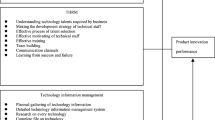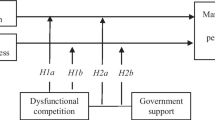Abstract
A challenge facing local firms in China is the selection of effective technology strategies to compete against MNEs in the era of globalization. The existing literature suggests two alternatives, developing strong manufacturing capabilities or developing innovation capabilities, but provides no clear answer to the question of how to select one strategy or the other. This paper explores this issue by introducing two concepts: “barriers to appropriability” and “opportunities for improvement.” We develop four propositions to specify the boundary conditions for local firms to choose their technology strategies and analyze two local firms’ technology strategies to illustrate two of the propositions. We find that development of strong manufacturing capabilities will not necessarily be an effective strategy for local firms competing against MNEs. If there are opportunities for improvement, it might be possible for local firms to compete against MNEs by developing innovation capabilities and core technologies.
Similar content being viewed by others
References
Amsden, A. (2001). The rise of “the rest”: Challenges to the west from late-industrializing economies. Oxford: Oxford University Press.
Amsden, A., & Chu, W.-W. (2003). Beyond late development: Upgrading policies in Taiwan. Cambridge, MA: The MIT Press.
Amsden, A., & Hikino, T. (1993). Borrowing technology or innovating: An exploration of the two paths to industrial development. In R. Thomson (Ed.), Learning and technological change (pp. 243–266). St. Martin’s Press.
Asia Technology Information Program (ATIP): REPORT: ATIP00.025: HPC-Asia 2000, http://www.atip.org/report_det.php?intID=25
Barney, J. B. (1986). Strategic factor markets: Expectations, luck, and business strategy. Management Science, 32(10), 1231–1241.
Bartlett, C. A., & Ghoshal, S. (1989). Managing across borders: The transnational solution. Boston, MA: Harvard Business School Press.
Buckley, P. J., & Casson, M. (1976). The future of the multinational enterprise. London: The Macmillan Press Ltd.
Burgelman, R. A. (2002). Strategy is destiny. New York, NY: The Free Press.
Carroll, P. (1993). Big blue: The unmaking of IBM. New York: Crown Publishers, Inc.
Chandler, A. D., Jr. (1962). Strategy and structure: Chapters in the history of the American Industrial Enterprise. Cambridge, MA: The MIT Press.
Chen, M.-J. (1996). Competitor analysis and inter-firm rivalry: Toward a theoretical integration. Academy of Management Review, 21(1), 100–134.
Christenson, C. M., & Bower, J. (1996). Customer power, technology investment, and the failure of leading firms. Strategic Management Journal, 17(3), 197–218.
Christenson, C. M., & Rosenbloom, R. S. (1995). Explaining the attacker’s advantage: Technological paradigms, organizational dynamics, and the value network. Research Policy, 24(2), 233–257.
Chung, K., & Lee, K. (1999). Mid-entry technology strategy: The Korea experience with CDMA. R&D Management, 29(4), 352–363.
Clark, K. B. (1985). The interaction of design hierarchies and market concepts in technological evolution. Research Policy, 14(5), 235–251.
Cohen, W. M., & Levinthal, D. A. (1990). Absorptive capacity: A new perspective on learning and innovation. Administrative Science Quarterly, 35(1), 128–152.
Cusumano, M. A. (1985). The Japanese automobile industry: Technology and management at Nissan and Toyota. Cambridge, MA: Harvard University Press.
Dertouzos, M. L., Lester, R. K., Solow, R. M., & the MIT Commission on Industrial Performance (1989). Made in America: Regaining the productive edge. Cambridge, MA: The MIT Press.
Dierickx, I., & Cool, K. (1989). Asset stock accumulation and the sustainability of competitive advantage. Management Science, 35(2) 1504–1511.
Doz, Y. (1986). Strategic management in multinational companies. Oxford: Pergamon Press.
Dunning, J. H. (1992). Multinational enterprises and the global economy. Reading, MA: Addison-Wesley Publishing Company.
Foster, R. N. (1986). Innovation: The attacker’s advantage. NY: Summit Books, Simon, and Schuster.
Freeland, R. F. (1996). The myth of the M-Form? governance, consent, and organizational change. American Journal of Sociology, 102(2), 483–526.
Gao, X. (2003). Technological capabilities catching up: Follow the normal way or deviate. Ph.D. Dissertation, MIT Sloan School of Management.
Grimm, C. M., & Smith, K. G. (1997). Strategy as action: Industry rivalry and coordination. Cincinnati, OH: South-Western College Publishing.
Hamel, G., Doz, Y., & Prahalad, C. K. (1989). Collaborate with your competitors and win. Harvard Business Review, 67(1), 133–139.
Henderson, R. M. (1993). Underinvestment and incompetence as responses to radical innovation: evidence from the photolithographic alignment equipment industry. Rand Journal of Economics, 24(2), 248–270.
Henderson, R. M., & Clark, K. (1990). Architectural innovation: The reconfiguration of existing product technologies and the failure of established firms. Administrative Science Quarterly, 35(1), 9–30.
Hikino, T., Harada, T., Tokuhisa, Y., & Yoshida, J. (1998). The Japanese puzzle. In A. Arora, R. Landau, & N. Rosenberg (Eds.), Chemicals and long-term economic growth: Insights from the chemical industry (pp. 103–135). New York, NY: John Wiley & Sons, Inc.
Hobday, M. (1990). Telecommunications in developing countries: The challenge from Brazil. London: Routledge.
Hymer, S. (1976). The international operations of national firms: A study of direct foreign investment. Cambridge, MA: The MIT Press.
Iansiti, M. (1998). Technology integration: Making critical choices in a dynamic world. Boston, MA: Harvard Business School Press.
Katz, R., & Allen, T. J. (1982). Investigating the not invented here (NIH) syndrome: A look at the performance, tenure, and communication patterns of 50 R&D project groups. R&D Management, 12(1), 7–19.
Kim, L. (1997). Imitation to innovation: The dynamics of Korea’s technological learning. Boston, MA: Harvard Business School Press.
Kim, L. (1998). Crisis construction and organizational learning: capability building in catching-up at Hyundai motor. Organization Science, 9(4), 506–521.
Kogut, B., & Zander, U. (1995). Knowledge, market failure and multinational enterprise: A reply. Journal of International Business Studies, 26(2), 409–415.
Lee, K., & Lim, C. (2001). Technological regimes, catching-up and leapfrogging: Findings from Korea industries. Research Policy, 30(3), 459–483.
Leonard-Barton, D. (1995). Wellspring of knowledge: Building and sustaining the sources of innovation. Cambridge, MA: Harvard Business School Press.
Lester, R. K. (1998). The productive edge: A new strategy for economic growth. New York and London: Norton and Company.
Liu, X. (2001). China’s technological innovation system in the 21st Century (in Chinese). Beijing: Beijing University Press.
Lou, Y. (2000). Dynamic capabilities in international expansion. Journal of World Business, 35(4), 355–378.
Lu, F., & Mu, L. (2003). Indigenous innovation, capability development, and competitive advantage (in Chinese). Management World, 2003(12), 57–82.
Lyons, N. (1976). The Sony vision. New York, NY: The Crown Publishers, Inc.
Magazine, I. C., & Patinkin M. (1989). General electric: The heart of an American product. In A. A. Thompson, W. E. Fulmer, & A. J. Strickland, III (Eds.), Readings in strategic management (pp. 189–221). Boston, MA: Irwin.
Makadok, R. (2001). Toward a synthesis of the resource-based and dynamic capability views of rent creation. Strategic Management Journal, 22(5), 387–401.
Mowery, D., & Nelson, R. (Eds.) (1999). Sources of industrial leadership: Studies of seven industries. Cambridge: Cambridge University Press.
Pavitt, K. (1985). Technology transfer among the industrially advanced countries: An overview. In N. Rosenberg & C. Frischtak (Eds.), International technology transfer: Concepts, measures, and comparisons (pp. 3–23). New York: Praeger.
Penrose, E. T. (1959). The theory of the growth in the firm. Oxford: Oxford University Press.
Perez, C., & Soete, L. (1988). Catching up in technology and windows of opportunity. In G. Dosi, C. Freeman, R. Nelson, G. Silverberg, & L. Soete (Eds.), Technical change and economic theory (pp. 458–479). London and New York: Pinter Publishers.
Peteraf, M. A. (1993). The cornerstones of competitive advantage: A resource based view. Strategic Management Journal, 14(3), 179–191.
Pisano, G. (1994). Knowledge, integration, and the locus of learning: An empirical analysis of process development. Strategic Management Journal, 15(Winter Special Issue), 85–100.
Prahalad, C. K., & Hamel, G. (1990). The core competence of the corporation. Harvard Business Review, 68(3), 79–91.
Shen, X. (1999). The Chinese road to high technology: A study of telecommunications switching technology in the economic transition. London: Macmillan Press Ltd.
Studer-Noguez, I. (2002). Ford and the global strategies of multinationals: The North American auto industry. London and New York: Routledge.
Sun, J. (2001). The management models of Haier (in Chinese). Beijing: The Enterprise Management Press.
Teece, D. J., Pisano, G., & Shuen, A. (1997). Dynamic capabilities and strategic management. Strategic Management Journal, 18(7), 509–533.
Tushman, M. L., & Rosenkopf, L. (1992). Organizational determinants of technological change. Research in Organizational Behavior, 14, 311–347.
Utterback, J. M. (1994). Mastering the dynamics of innovation. Boston, MA: Harvard Business School Press.
Wang, X. (1999). Experiences in developing the Huaguang Electronic Publishing System (in Chinese). Beijing: Beijing University Press.
Wernerfelt, B. (1984). A resource-based view of the firm. Strategic Management Journal, 5(2), 171–180.
Westphal, L. E., Kim, L., & Dahlman C. J. (1985). Reflection on the Republic of Korea’s acquisition of technological capabilities. In N. Rosenberg & C. Frischtak (Eds.), International technology transfer: Concepts, measures, and comparisons (pp. 167–221). New York: Praeger.
Womack, J. P., Jones, D. T., & Roos, D. (1991). The machine that changed the world. New York, NY: Harper Perennial.
Wu, C. (2001). Theoretical basis for modern manufacturing system (in Chinese). Unpublished manuscript, Tsinghua University, Beijing.
Xie, W. (2001). Catching up and price war: A study of the Chinese color TV set industry and the automobile industry (in Chinese). Beijing: Economy and Management Press.
Xu, L. (2002) Resources and capabilities in high-tech entrepreneurship development: A study on Chinese high-tech startups. PhD Dissertation, MIT Sloan School of Management.
Yin, R. K. (1989). Case study research: Design and methods. Newbury Park, CA: Sage Publications.
Zaheer, S., & Mosakowski, E. (1997). The dynamics of the liability of foreignness: A global study of survival in financial services. Strategic Management Journal, 18(6), 439–464.
Zhang, Q. (2000). PTIC: Made by China (in Chinese). Beijing: China Yanshi Press.
Zhang, M. (2001a). Technology leapfrog: Strategy and management (in Chinese). Beijing: China Economy Publishing House.
Zhang, W. (2001b). Analysis of TCL’s high growth rate. Unpublished manuscript. The Development Research Center of the State Council, Beijing.
Zhao, Y. (2003). The debate on technology buying and indigenous innovation. Liaowang Weekly, 2003(27), 14–16.
Acknowledgments
The authors want to thank the MIT Sloan School of Management and the MIT Industrial Performance Center for providing financial support for this study, and thank Dawning and Hisense for providing the opportunity for us to do the case studies. We also want to thank George Farris, Richard Lester, Yadong Lou and all other reviewers for their insightful comments and suggestions. Special thanks go to Mingfang Li for his excellent leadership and professional commitment in organizing this special issue.
Author information
Authors and Affiliations
Corresponding author
Rights and permissions
About this article
Cite this article
Gao, X., Zhang, P. & Liu, X. Competing with MNEs: developing manufacturing capabilities or innovation capabilities. J Technol Transfer 32, 87–107 (2007). https://doi.org/10.1007/s10961-006-9002-2
Published:
Issue Date:
DOI: https://doi.org/10.1007/s10961-006-9002-2




